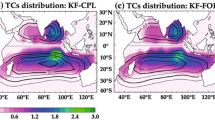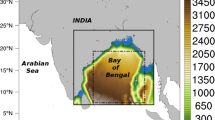Summary
Tropical cyclone (TC)—ocena feedbacks are studied using a coupled tropical cyclone-ocean model consisting of an eightlayer triply-nested movable grid model of a TC and a three-layer primitive equation ocean model. The numerical results indicate that the TC-ocean interaction influences intensities, structures, and the trajectories of tropical cyclones. Two possible mechanisms, barotropic and baroclinic, influencing TC tracks under TC-ocean interaction are suggested. The barotropic mechanism is related to the changes of the vertically averaged TC structure, induced by the TC-ocean coupling. The baroclinic mechanism is related to the asymmetry of the condensation heating within the TC caused by the asymmetry of heat and moisture fluxes at the sea surface. This asymmetry arises due to the asymmetry in sea surface cooling relative to the storm center. The experiments indicate that the influence of TC-ocean interaction on the TC tracks is the greatest for the case of a zero background flow. In the case of a non-zero background flow the sensitivity of storm tracks to the coupling with the ocean decreases. It is found that the influence of the ocean coupling on the TC track is quite sensitive to the method of convective heating parameterization in the TC model. The TC-ocean interaction also results in a change of the amount and spatial distribution of precipitation.
Similar content being viewed by others
References
Black, P. G., 1983: Ocean temperature change induced by tropical cyclones. Ph. D. dissertation. Pennsylvania State University, 277 pp.
Chang, S. W., 1979: The response of an axisymmetric model of tropical cyclone to local variations of sea surface temperature.Mon. Wea. Rev.,107, 662–666.
Chang, S. W., Anthes, R. A., 1979: The mutual response of the tropical cyclone and the ocean.J. Phys. Oceanogr 9, 128–135.
Charnock, H., 1955: Wind stress, on a water surface.Quart. J. Roy. Meteor. Soc.,81, 639–640.
Deardorff, J. W., 1972: Parameterization of the planetary boundary layer for use in general circulation models.Mon. Wea. Rev.,100, 93–106.
Deardorff, J. W., 1983: A multi-limit mixed layer entrainment formulation.J. Phys. Oceanogr.,13, 988–1002.
DeMaria, M., Kaplan, J., 1993: Sea surface temperature and the maximum intensity of Atlantic tropical cyclones.J. Climatol., (submitted).
Emanuel, K. E., 1988: The maximum intensity of hurricanes.J. Atmos. Sci.,45, 1143–1155.
Emanuel, K. E., 1991: The theory of hurricanes.Ann. Rev. Fluid Mech.,23, 179–196.
Falkovich, A. I. 1979:Dynamics and Energetics of the Intertropical Convergence Zone. Leningrad: Gidrometizdat, 247 p. (in Russian).
Falkovich, A. I., 1986: A nested-grid scheme for predicting isolated vortex motion in a barotropic atmospheric model.Soviet Meteorology and Hydrology,9, 35–41.
Falkovich, A. I. 1988: Adaptation of meteorological fields in a baroclinic model.Soviet Meteorology and Hydrology,n6, 29–42.
Falkovich, A. I., Kulakov, A. V. 1986: On prediction of single vortex motion.Soviet Meteorology and Hydrology,n8, 58–65.
Falkovich, A. I. Khain, A. P., Ginis, I. D., 1982: Studying of the development and motion of tropical cyclones by use of a coupled ocean-atmosphere model.Soviet Meterology and Hydrology,n2, 23–39.
Fernando, H. J. S., 1991: Turbulent mixing in stratified fluid.Ann. Rev. Fluid Mech.,23, 455–493.
Fiorino, M., Elsberry, R. L., 1989: Some aspects of vortex structure related to the tropical cyclone motion.J. Atmos. Sci.,47, 975–990.
Ginis, I. D., Dikinov, Kh. Zh., Khain, A. P., 1989: A three-dimensional atmosphere-ocean model in the zone of a tropical cyclone.Dokl. Akad. Sci. USSR,307, 333–337.
Ginis, I. D., Dikinov, Kh. Zh., 1989: Modeling of the typhoon Virginia (1978) forcing on the ocean.Soviet Meteorology and Hydrology,n7, 53–60.
Hawkins, H. F., Rabsam, D. T., 1968: Hurricane Hilda, 1964. II. Structure and budgets of the hurricane on October 1., 1964.Mon. Wea. Rev.,96, 617–637.
Hawkins, H. F., Imbembo, S. M., 1976: The structure of a small intense hurricane Inez, 1966:Mon. Wea. Rev.,104, 418–442.
Hazelworth, J. B., 1968: Water temperature variations resulting from hurricanes.J. Geophys. Res.,73, 5105–5123.
Holland, G. J., 1983: Tropical cyclone motion: environmental linteraction plus beta effect.Atmos. Sci. Paper,348, 47–47 pp.
Holland, G. J., 1983: Tropical cyclones in the Australian/ Southwest Pacific region.Atmos. Sci. Paper,363, 264 pp.
Holland, G. J., Merrill, R. T., 1984: On the dynamics of tropical cyclone structural changes.Quart. Roy. Meteor. Soc.,110, 723–745.
Ivanov, V. N., Pudov, V. D., 1977: Structure of the thermal wake of typhoon Tess in the ocean and estimation of the certain energy-exchange parameters under storm condition. In collection: Typhoon-75, Gidrometeoizdat, Leningrad,1, 66–82.
Johnson, A., Withee, J. W., 1978: Ocean data buoy measurements of hurricane Eloise.Mar. Technol. Soc. J.,12, 14–20.
Jones, R. W., 1980: A three-dimensional tropical cyclone model with release of latent heat by the resolvable scales.J. Atmos. Sci.,37, 930–938.
Khain, A. P., 1979: The 12-level axisymmetry numerical tropical cyclone model.Soviet Meteorology and Hydrology,n10, 23–37.
Khain, A. P., 1980: Response of an axisymmetric tropical cyclone to changes of ocean surface temperature and evaporation from the sea surface.Soviet Meteorology and Hydrology,n10, 59–63.
Khain, A. P., 1983: Numerical tropical cyclone model with a calculation of condensation by the resolvable scales.Izvestia, Atmospheric and Oceanic Physics,19, 341–346.
Khain, A. P., 1984:Mathematical Modeling of Tropical Cyclones. Leningrad: Gidrometeoizdat, 247 pp. (in Russian).
Khain, A. P., 1988: A Three-dimensional numerical model of tropical cyclone with allowance for the beta-effect.Izvestia, Atmospheric and Oceanic Physics,24, 266–271.
Khain, A. P., Agreinich, E. A., 1978: Features of the boundary and the marine atmospheric surface layers in tropical cyclones.Soviet Meteorology and Hydrology n1, 24–34.
Khain, A. P., Sutyrin, G. G. 1983:Tropical Cyclones and Their Interaction with the Ocean. Leningrad Gidrometizdat, 247 p. (in Russian).
Khain, A. P., Ginis, I. D., 1991: The mutual response of a moving tropical cyclone and the ocean.Beitr. Phys. Atmos.,64/2, 125–142.
Krishnamurty, T. N., Bedi, H. S., Yap, K. S., Oosterhof D., Rohaly, G., 1992: Recurvature dynamics of a typhoon.Meteorol. Atmos. Phys. 50, 105–126.
Kuo, H. L., 1974: Further studies of the parameterization of the influence of cumulus convection on large-scale flow.J. Atmos. Sci.,31, 1232–1240.
Kurihara, Y., Tripoli, G. J., Bender, M. A., 1979: Design of a movable nested-mesh primitive equation model.Mon. Wea. Rev.,107, 239–249.
Leipper, D. L., 1967: Observed ocean conditions and hurricane Hilda, 1964.J. Atmos. Sci.,24, 182–196.
Maeda, A., 1971: Changes of water temperature near ocean weather station “T” before and after passage a typhoon.J. Oceanogr. Soc. Jap.,27, 109–115.
Marchuk, G. I., 1982:Methods of Numerical Mathematics. New York: Springer, 510 p.
Mathur, M. B., 1992: Tropical storm motion and structure in a fine mesh primitive equation model.Meteorol. Atmos. Phys.,50, 127–142.
McFadden, J. D., 1967: Sea-surface temperature in the wake of hurricane Betsy (1965).Mon. Wea. Rev.,95, 299–302.
Merrill, R. T., 1987: An experiment in statistical prediction of tropical cyclone intensity change. NOAA Tech. Memo. NWS NHC-34, 34 p.
Moss, M. S., Rosenthal, S. L., 1975: On the estimation of planetary boundary layer variables mature hurricanes.Mon. Wea. Rev. 193, 980–986.
Neumann, C. J., 1993: Global overview. Global guide to tropical cyclone forecasting.World Meteor. Organiz. Geneva, Switzerland, 1.1–1.56.
Orlanski, I., 1976. A simple boundary conditions for unbounded hyperbolic flows.J. Comput. Phys. 21, 251–269.
Pekelis, E. M., Pressman, D. Y., 1982: Numerical implementation of radiation boundary conditions and their applications to the conditions of “open boundaries” for numerical integration of the equations of convection.Trudy Gidrometcentra USSR,249, 74–95.
Perlroth, I., 1969: Effects of oceanographic media on equatorial Atlantic hurricanes.Tellus,21, 230–244.
Pressman, D. Y., 1968: Integration of complete equations of short-range weather forecasting according to explicit differential schemes.Trudy Gidrometcentra USSR,16, 3–18.
Price, J. F., 1981: Upper ocean response to a hurricane.J. Phys. Oceanogr. 11, 153–175.
Ramage, C. S., 1972: Interaction between tropical cyclones and the China Sea.Weather,27, 484–494.
Raymond, W. H., Kuo, H. L., 1984: A radiation boundary condition for multi-dimensional flows.Quart. J. Roy. Meteor. Soc.,110, 535–552.
Rosenthal, S. L., 1978: Numerical simulation of tropical cyclone development with latent heat by the resolvable scales. I. Model description and preliminary results.J. Atmos. Sci.,35, 258–271.
Sanford, T. B., Black, P. G., Haustein, J., Fenney, J. W., Forristal, G. Z., Price, J. F., 1987: Ocean response to hurricanes. Part 1: Observations.J. Phys. Oceanogr. 17, 2065–2083.
Sanford, T. B., Black, P. G., Haustein, J., Fenney, J. W., Forristal, G. Z., Price, J. F., 1987: Ocean response to hurricanes. Part 1: Observations.J. Phys. Oceanogr.,17, 2065–2083.
Shay, L. K., Black, P. G., Mariano, A. J., Hawkins, J. D., Elsberry, R. L., 1992: Upper ocean response to Hurricane Gilbert.J. Geophys. Res.,97, 20227–20248.
Schopf, P. S., Cane, M. A., 1983: On equatorial dynamics, mixed layer physics and sea surface temperature.J. Phys. Oceanogr.,13, 917–935.
Shapiro, L. J., 1992: Hurricane vortex motion and evolution in a three-layer model.J. Atmos. Sci.,49, 140–153.
Shapiro, L. J., Ooyama, K. V., 1990: Barotropic vortex evolution on a beta-plane.J. Atmos. Sci.,47, 170–187.
Shuman, F. G., Hovermale, J. B., 1968: An operational sixlayer primitive equation model.J. Appl. Meteor.,7, 525–547.
Smagorinsky, J., 1963: General circulation experiments with the primitive equations. Part 1: The basic experiment.Mon. Wea. Rev.,91, 99–164.
Stein, U., Alpert, P., 1991: Inclusion of sea moisture flux in the Anthes-Kuo cumulus parameterization.Beitr. Phys. Atmos.,64/2, 231–244.
Sutyrin, G. G., 1987: The beta effect and the evolution of an intense vortex on a rotating globe.Sov. Phys. Dokl.,32, 791–793.
Sutyrin, G. G., Khain, A. P., Agrenich, E. A., 1979: Interaction of the boundary layers of the ocean and atmosphere in a tropical cyclone.Soviet Meteorology and Hydrology,n2, 37–46.
Sutyrin, G. G., Khain, A. P., 1984: On the effect of air—ocean interaction on intensity of moving tropical cyclone. Izvestia,Atmospheric and Oceanic Physics,20, 787–794.
Tuleya, R. E., Kurihara, Y., 1982: A note on the sea surface temperature sensitivity of a numerical model of tropical storm genesis.Mon. Wea. Rev.,110, 2065–2071.
Weatherford, C. L., Gray, W. M., 1988: Typhoon structure as revealed by aircraft reconnaissance. Part 1: Data analysis and climatology.Mon. Wea. Rev.,116, 1032–1056.
Willoughby, H. E., 1988: Linear motion of ahallow-water barotropic vortex.J. Atmos. Sci.,45, 1906–1928.
Willoughby, H. E., 1990: Temporal changes of the primary circulation in tropical cyclones.J. Atmos. Sci.,47, 242–264.
Willoughby, H. E., 1992: Linear motion of a shallow-water barotropic vortex as an initial value problem.J. Atmos. Sci.,49, 2015–2031.
Willoughby, H. E., Chelmow, M. B., 1982: Objective determination of hurricane tracks from aircraft observations.Mon. Wea. Rev.,110, 1298–1305.
Wright, R., 1969: Temperature structure across the Kurosio before and after typhoon Shirly.Tellus. 21, 409–413.
Author information
Authors and Affiliations
Rights and permissions
About this article
Cite this article
Falkovich, A.I., Khain, A.P. & Ginis, I. The influence of air-sea interaction on the development and motion of a tropical cyclone: Numerical experiments with a triply nested model. Meteorl. Atmos. Phys. 55, 167–184 (1995). https://doi.org/10.1007/BF01029825
Received:
Revised:
Issue Date:
DOI: https://doi.org/10.1007/BF01029825




